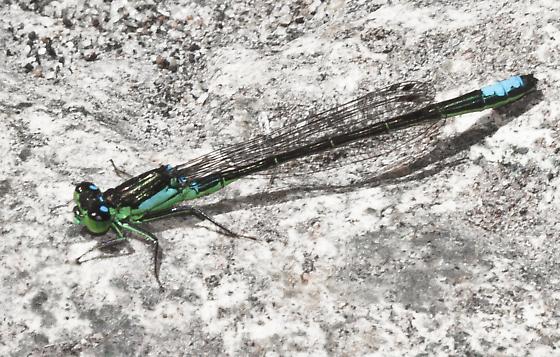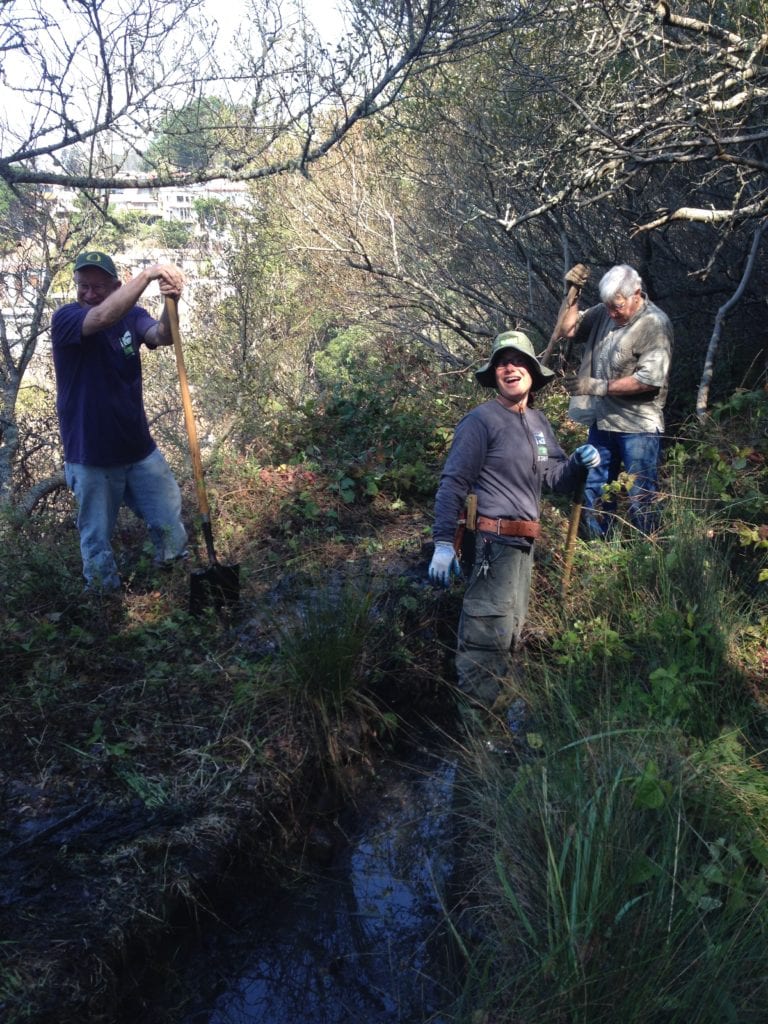
By Murray Schneider
The lovely, iridescent and exceedingly rare San Francisco forktailed damselfly once thrived in Glen Canyon before going extinct due to the buildup of Diamond Heights and the loss of much of the clear flowing water in Islais creek that the damsels require.
Reintroduced in 2006, the graceful, endangered dragonfly-like creatures are clinging to survival, existing in only tiny populations in a few areas within San Francisco. Fewer than ten breeding populations are all that’s left, all threatened and all within the city limits of San Francisco. Where once rains and watershed would have scoured the creek clean, now human shoulders, shovels and hard work are all that stands between these blue-green beauties with their characteristic bars of teal on their long, elegant tails.
That work was carried out in October by a stalwart band of long-standing Friends of Glen Canyon Park volunteers. They carried hand saws and shovels, loppers, too. They angled upward, scaling the eastern slope of Glen Canyon on a fall day that settled into the high 70s. Their destination lay just below George Christopher Playground, at a ditch caked with sludge—pounds of it.
Pancaked mud prevented a culvert’s water from flowing, fulfilling its role as salutary habitat for the rare San Francisco forktail damselfly (Ischnura gemina), which requires permanent fresh water marshes or open aquatic habitat to survival.
Led by Recreation and Park gardener Shelley Arnold, the volunteers reached the gully, cloaked in arroyo willow and hedged by California and Himalayan blackberry. There they found a braided quilt of canyon foliage that obstructed the water in the clogged trough from running its course.

In its daily efforts at canyon stewardship of all sorts, Rec and Park’s Natural Areas Program gardeners annually remove plant growth and silt in drainage channels such as the one that now greeted the volunteers. Today their job was to remove the overhanging branches and unclog the channel.
In doing so, one of our state’s most endangered damselflies, at risk of extinction in the wild, was given a last ditch chance at survival.
Steve Uchida who lives on Monterey Boulevard, Jim Hanratty who lives on Stillings Avenue and Sam Orr who lives on Gates Street in Bernal Heights selected a tool and set about the muddy task.
Jumping the ditch and gaining the side closest to Christopher Playground, Uchida set about manicuring its bank, pushing back blackberry. Uchida ran interference for Arnold, his Natural Areas Program supervisor. Arnold planted a foot in the canal and with singular stabs of her shovel repeatedly scooped heaps of gunk onto the other side of the trench from where Uchida worked his lopper.
Sam Orr and Jim Hanratty moved farther along the channel, coming upon a willow bough that lay athwart the trench. It spawned spokes of lichen-caked branches. With loppers, the two set about pruning the offshoots and removing the debris to a sacrifice pile Arnold had earlier located on the downslope.
Uchida hopscotched several times past Arnold while Orr and Hanratty continued working. Hanratty had shed his sweatshirt within minutes, and by the time the two had worked 30 minutes Orr’s cotton shirt was painted with puddles of perspiration.
A low lying willow limb threatened a path to Arnold’s sacrifice pile, so Orr lay down his lopper, picked up a hand saw and removed it.
Earlier, Arnold had tutored the volunteers on how to efficaciously make an initial undercut before tackling the dorsal side of a limb.
While Orr made true cuts on the branch that, left ignored, might have crowned an unsuspecting hiker, Arnold continued lifting muck from the channel. Heaps of the glob now oozed along the bank opposite Uchida.
The quartet worked for two hours without stopping. They’d started at 9:30 a.m. By half past eleven the trench ran unimpeded, ready for damselflies to feast upon the now day-lighted invertebrate bounty.
Mounds of sopping dirt tented along the channel and the emancipated water glistened in the sunlight, already attracting a number of flies, a mosquito or two, even a worm that wiggled close to the near bank.
Standing ankle deep in the middle of the gully, Arnold called a halt to the morning’s activity, a smile creasing her face, knowing she’d schedule an additional two hours of work the following week.
Diamond Heights houses, perched on Franciscan chert cliffs, loomed behind her in the near distance. The development of housing and commercial sites in the 1960s resulted in habitat destruction, including reduction of water sheds required by the damselfly.
Hanratty leaned over his shovel while Orr stamped one more time on his. Uchida gathered several loppers and each grabbed shirts or backpacks preparatory to retracing their way back down the canyon hillside.
At their elevated ages, going downhill is easier than walking up.
Arnold carried four saws in one hand and half way down the box steps she transferred a couple to Orr. She continued carrying several shovels. She volunteered that her wrist throbbed, possibly a recipe for tendonitis, an occupational hazard City gardeners face who manage significant natural areas such as Glen Canyon.
Rec and Park logs thousands of hours of neighborhood volunteer time each year, which go a long way insuring that Arnold’s wrist ails don’t escalate.
At the waiting Rec and Park truck the men drank water. Rested, as well.
They’d been hanging with one another for years now. They enjoy the weekly work, but truth-be-told they like the camaraderie just as much. Uchida retired as a U.S. postal worker, Hanratty as an engineer and Orr as a journalist, and in-between pruning willow and shoveling dirt they banter and joke.
They keep it simple: films, family, friends.
But always the canyon.
When all is said and done, it’s Glen Canyon and its wild things that bind them together.
Each Wednesday.